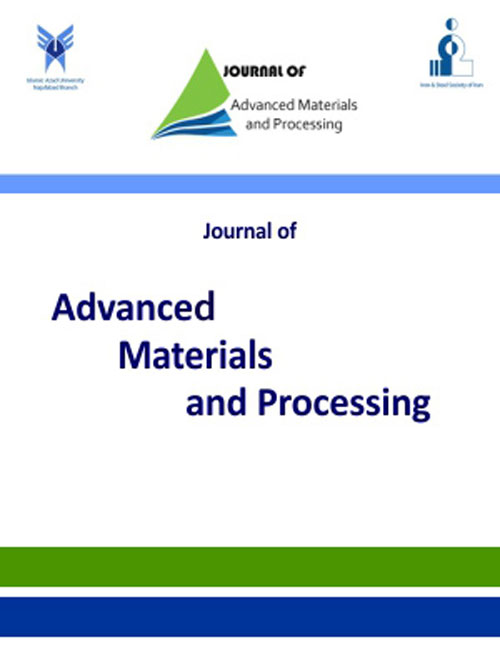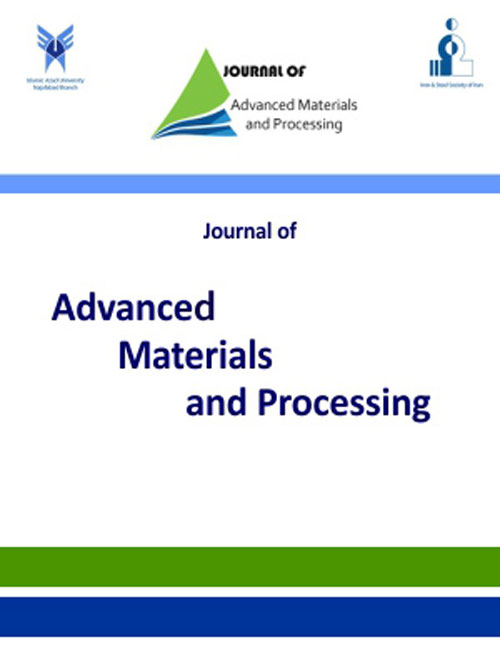فهرست مطالب

Journal of advanced materials and processing
Volume:7 Issue: 2, Spring 2019
- تاریخ انتشار: 1398/03/11
- تعداد عناوین: 7
-
-
Fatigue Characterization of High Performance Hybrid Aluminium AA 5083/SiCp/Fly Ash Metal Matrix CompositesPages 3-9Fatigue of the components is a critical aspect that needs to be addressed for effectively using the Aluminium Metal Matrix Composites in a variety of applications, especially the aircraft components, since the damage that occurs due to fatigue is progressive and may lead to overall failure of the structure of the aircraft. Henceforth in the present work, the fatigue behavior of Aluminium AA 5083 Matrix reinforced with varying weight percentage of silicon carbide viz., 3, 5, 7 and 9 and varying weight percentage of fly ash viz., 2, 3, 4 and 5 and fabricated enroute the process of stir casting at four different parameters viz., the stirring speed of 50, 100, 150 and 200 rpm, and the stirring duration of 15, 20, 25 and 30 min are evaluated. The main purpose of fatigue characterization accomplished in accordance with ASTM F1160 standards on a typical RR Moore rotating beam fatigue testing machine is to distinctly evaluate the life cycle of components that are fabricated from metal matrix composites and eventually develop a framework model for the significant study of fatigue strength of the structure with persistent striations all along the interstitial of aluminium-silicon carbide-fly ash interfaces. Fatigue is a stochastic process rather than a deterministic one, thus in the present work, Analysis of Variance (ANOVA) is carried out to establish the authenticity of the results and validate them. The results and plots are presented with suitable rationale and inferences considering the stress range, stress amplitude and number of cycles to failure.Keywords: Fatigue, Aluminium AA 5083, Silicon Carbide, Fly ash, Statistical Validation
-
Mechanical Characterization of Hemp Cotton Hybrid Composites: Effect of Surface TreatmentPages 10-21Over a past few decade there have been extensive research noted on fiber reinforce polymer matrix composites, moreover in recent years there has been remarkable study on natural fiber polymer matrix composites due to its capability to sustain against the synthetic fibers and conventional materials. This helps in achieving more desirable material properties for an existing application. In line with this in the present study the composite with the treated and untreated hemp – cotton hybrid mat and epoxy resin prepared with hand layup compression moulding technique. The prepared composites were tested for the tensile strength, flexural strength, impact strength and hardness using American society of testing and materials (ASTM) standards. The test results reveals that the treated fiber composites exhibits significant increase in the tensile strength and hardness while there was a reduction in flexural strength. The focus of the study was to compare the mechanical properties of these composites with the various materials to identify which materials could completely or partially replaced.Keywords: Natural Fiber Reinforced Polymer Matrix Composites, Surface Treatment, Mechanical Characterization
-
Pages 22-33The AZ31 magnesium alloy has a significant potential for the aircraft manufacturing industry due to its low density and proper mechanical properties. In this research, the Gas Tungsten Arc Welding (GTAW) process was used by applying pulse current for the AZ31 as-cast alloy joint. The GTAW process is conducted by pulse time, voltage, and equivalent current of 0.5 sec, 12 V, 187.5 A, respectively. Then, the surface of welded joint by the GTAW was improved using friction stir processing (FSP). The effect of FSP on the microstructure and mechanical properties of this joint was examined. Subsequently, the friction stir processing was performed with a tool rotating speed of 1120 rpm, the tool traverse speed of 50 mm/min in two passes behind and on the welding line. The microstructure and fracture sections of the prepared samples were respectively examined by optical microscopy and scanning electron microscopy (SEM). The mechanical behavior of the samples was studied using tensile, micro-hardness and impact tests. According to the results, the microstructure of the welding region of the TIG sample included highly fine homogeneous and coaxial grains. After the friction stir process (FSP), the microstructure transformed into fine and structural grains in the form of a ring-shaped morphology. The FSP resulted in a 23% improvement in the tensile strength of the TIG sample. Also, the impact energy of the welding metal increased by about 37%. In general, the mechanical behavior of the joint was improved after applying the friction stir process.Keywords: AZ31 Casting (Az-cast) Alloy, Friction Stir Process (FSP), Gas Tungsten Arc Welding (GTAW), Mechanical Properties, Microstructure
-
Processing of aluminum flake powder via high energy ball milling under different conditions reaching to aluminum nanoparticlesPages 31-42The wet ball milling process has been employed to produce aluminum nanoparticles via processing of aluminum flake powder with average particle size about 20 μm at which different three solvents were used as milling solvents under ambient conditions without injection of inert gas. Those solvents were kerosene, 1,4 dioxane and 2-ethyl-hexanol. The milling process was achieved at different milling speeds, such were 300, 400, and 500 rpm. The different characteristics of the fabricated aluminum powder were investigated via XRD, EDX, SEM and TEM investigations. The different three solvents successfully contributed to reduce the particle size of aluminum flake powder down to ~ 860, 285 and 235 nm after 50 hours with kerosene, 1,4 dioxane and 2-ethyl-hexanol respectively. That smaller particle size was combined with high percent of aluminum content and low contamination level. On the other hand, the wet ball milling was employed to prepare aluminum nanoparticles using kerosene as milling solvent under the injection of argon gas with longer milling time which was 60 hours. The average particle size of the sample prepared under argon was about 50- 80 nm with less amount of aluminum oxide.Keywords: Aluminum nanoparticles, Wet ball milling, Milling solvents, Kerosene
-
Pages 43-56Different ceramic coatings can be fabricated on aluminum alloys by the anodizing process. In this process, the nanocells can grow directly from the bottom toward the surface of the coating layer. The ordered porous structure of the anodic aluminum oxide (AAO) layer is a very suitable template for the growth of magnetic nanowires. At this study, one- and two-step anodizing processes were conducted to fabricate the oxide layer in an appropriate acidic electrolyte at three different temperatures (0, -5, -10 ⁰C) and three different voltages (20, 27, 35 V) for 50 min on a 7075 aluminium alloy (7075 AA). The results showed that the samples’ thickness increased with increasing the voltage and decreasing the temperature. The microhardness of samples under different voltages increased with decreasing the temperature. Field emission scanning electron microscopy (FESEM) images were taken from the back and cross-sections of nanocells. The results indicated that the samples which were anodized by the two-step process at -10 ⁰C and 35 V had yielded the best order. Afterward, Zn-Mn ferrite nanowires were produced by electrochemical deposition within the nanocells. X-ray diffraction (XRD) confirmed the formation of the Zn-Mn phase, and FESEM images showed the bulk morphology of nanowires with an appropriate saturation magnetization of about 63.64 emu/g.Keywords: anodizing, temperature, nanocells, ferrite, magnetic
-
Pages 57-62
In order to improve the surface quality and prevention of corrosion and reduction of wear in the components like gears and bearings, they can be covered with phosphate coatings. SCM420H alloy steel was coated with manganese phosphate deposition. The microstructure and corrosion resistance of the coating was studied by change of bath pH. In order to investigate the phase analysis and coating microstructure, X-ray diffraction (XRD) and scanning electron microscopy (SEM) were used, respectively. XRD analysis from the coated surface revealed the phases of MnFe2(PO4)2(OH)2H2O, Mn(PO)3، Fe(PO)3 and (Mn,Fe)5H2(PO4)4·4H2O. Results showed the obtained coating at pH=2.1 was uniform and continuous and no crack or porosity was observed. The phosphate surface at pH=1.9 and pH=2.4 was non-uniform and included cracks. In order to investigate the corrosion resistance, potentiodynamic polarization and electrochemical impedance spectroscopy (EIS) tests were applied on coated and uncoated specimens in 3.5% NaCl solution. The results of potentiodynamic polarization and electrochemical impedance spectroscopy tests were in agreement with microscopic images. The results of electrochemical impedance spectroscopy demonstrated that the formed manganese phosphate deposition in the bath with pH=2.1 had the highest polarization resistance (28020 Ω) compared to the formed coating in the bath at pH=1.9 (1480 Ω) and the formed coating in a bath with pH=2.4 (3155 Ω).
Keywords: Coating, pH, Potentiodynamic polarization, Electrochemical impedance spectroscopy -
Pages 64-73In this study, graphene oxide (GO), graphene oxide quantum dots (GOQD) and graphene quantum dots (GQD) were synthesized by Hummers, hydrothermal and the calcination in argon methods, respectively. Then the structure of the samples was characterized by X-ray diffraction, Fourier-transform infrared and Raman spectroscopies and their particle size distribution were investigated by dynamic light scattering. Afterward, the electrical and photoelectric properties of the samples were studied by electrical conductivity meter and diffuse reflectance and photoluminescence spectroscopies. Finally, the photoelectrochemical sensors were designed to detect dopamine (DA) based on GO, GOQD and GQD modified glassy carbon electrodes (GCE). The results showed that the sample of GO has graphene plates with widest particle size distribution (about 1.3 to 5.7 µm) and the highest electrical conductivity (287.9 µS/cm). On the other, the sample of GQD has narrowest particle size distribution (about 5.3 to 12.8 nm) and the lowest electrical conductivity (165.1 µS/cm). The samples of GOQD and GQD have light absorption throughout the range of visible wavelength and therefore have photoelectric behavior better than GO. As a result, in DA detection sensors, the photoresponse of the GCEs modified with GOQD and GQD is 4 times higher than that of GO modified GCE.Keywords: Graphene, Graphene quantum dots, Photoelectric property, Photo electrochemical sensor, Dopamine


